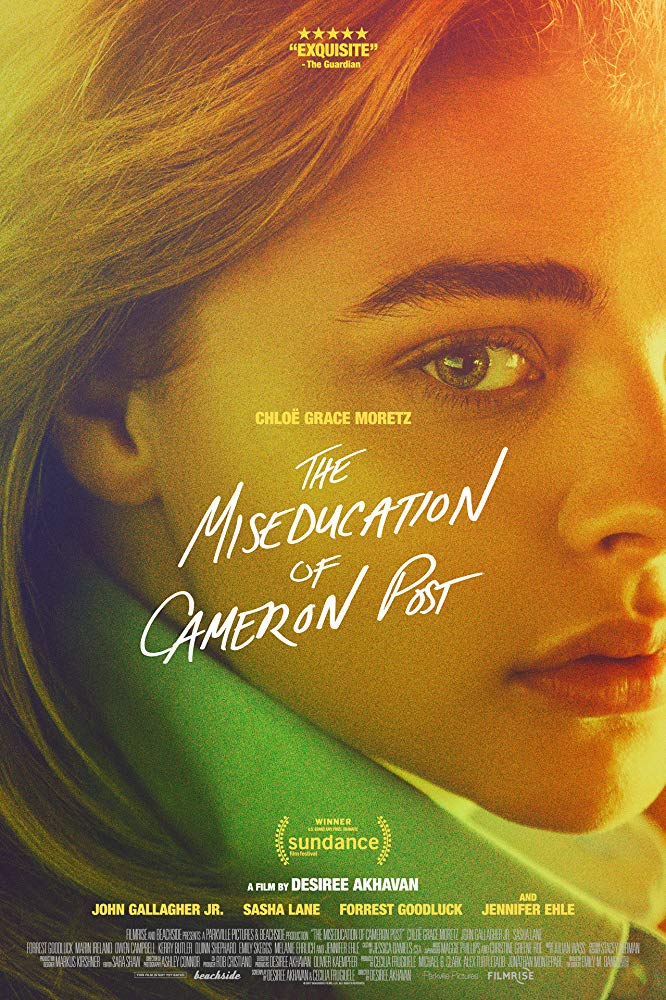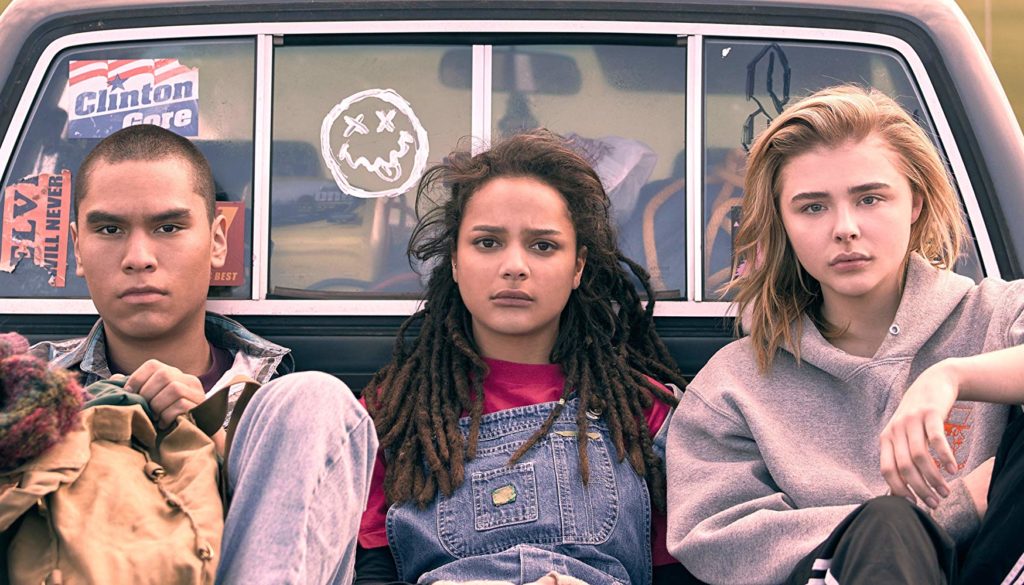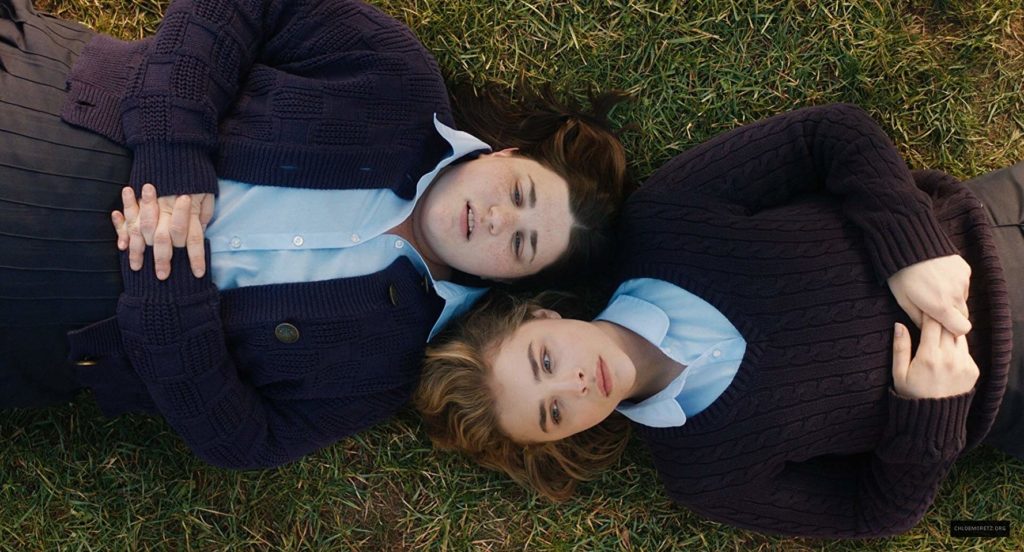Chloe Grace Moretz is the star of the indie, The Miseducation of Cameron Post.

Since her breakout role in 2010’s Kick-Ass, Chloe Grace Moretz had starred in high profile, largely studio films, such as Let Me In, Hugo, and If I Stay.
Moretz says she was ready for a change: “I had chosen to take some time off and basically reboot my career. I wanted to make movies that felt poignant and inspiring to me as a person and relevant to the state of world.”
Moretz knew director Desiree Akhavan from Appropriate Behavior and was keen to read the new screenplay: “I read it within an hour. I called my brother and said, ‘First of all, this is one of the most beautifully written scripts I’ve ever read. And secondly, this is the path that I want to go on in my career.”

Positive (Not Message) Movie
From the start it was clear that filmmaker and actor were of the same mind and goals. “Desi and I wanted this to be, at its core, a positive movie,” affirms Moretz. “We didn’t want to beat people over the head with a lesson. It was more about showing the viewer these beautiful interpersonal relationships among these teenage kids, who for the first time are coming into contact with other gay kids like themselves. Even though it’s under the veil of secrecy from the heads of the camp, they’re having their first moments of realization with each other that they’re not alone in this, that there are other people out there like them and that this isn’t crazy.”
Cameron has a solid sense of self; she’s not in denial about her sexuality nor is she ashamed. Moretz was struck by her character’s strength and clarity of mind as she reckons with her situation at God’s Promise. “Cameron is aware of what’s happening, what she’s going through. It’s like ‘Oh, shoot, I ended up here because I got caught. Not because I made a mistake but because I got caught,’” observes Moretz. “Cameron’s put into these horrific circumstances and has all these ideas forced upon her but she doesn’t sit there and brood. She does try her best to be the best person that she can be.”
Akhavan praises the depth and nuance Moretz brought to the role. “Chloe has such range and I don’t think that she’s any one thing. This is such a departure from how many people know her. She brought a kind of swagger to Cameron, a self-knowledge but vulnerability as well. It’s a delicate balance and she nailed it.”

Casting Siblings Lydia Marsh and Reverend Rick
Tony Award winners Jennifer Ehle (A QUIET PASSION, LITTLE MEN) and John Gallagher, Jr. (“Olive Kitteridge,” “The Newsroom”) signed on. “It was tricky because whoever we cast as Rick, we had to have the right Lydia and vice versa,” Akhavan explains. “One depended on the other. We all thought John and Jennifer were a great fit as brother and sister because they have a similar sensibility, an inherent kindness and intelligence.”
Ehle was intrigued by Lydia and took on the role despite a busy schedule. “I couldn’t pass up the challenge of finding a way into somebody who sees the world so differently from how I do,” she comments. “It was just feasible to squeeze it in. At first I was afraid that I wouldn’t have time to give it the thought and attention that Lydia needed and deserved and that the film needed and deserved. But I couldn’t let it go because I really loved it.”
Research helped her get a grasp on Lydia. She watched videos and read books about religious recruitment, conversion therapy and saving souls. “It was important to get a sense of what her point of view would be and what her beliefs are,” Ehle says. “Lydia doesn’t have a sadistic bone in her body and she believes that everything she is doing is a necessary evil to ensure the children’s happiness forevermore. Lydia truly believes that there is a forevermore to prepare for. If somebody really is doing something that is going to harm them for eternity, you want to stop them in any way you can. When you see a child about to put their hand into a flame, you do whatever you have to do to make them pay attention to you.”
John Gallagher, Jr.
Gallagher was interested in the project even before he read the screenplay. “I’d seen Approriate Behavior and thought Desiree was such a strong and exciting new filmmaker and I was really eager to see what she would create next. I jumped at the chance to get to work with her,” he affirms. “Then I read the script, which swept me away in all of its humanity. It was keenly observed and had a lot of heart and I believed and felt for all of the characters.”
He appreciated the portrait of Reverend Rick as a quietly conflicted man who sought to provide an example of someone who was happily cured of homosexuality. “Rick is a kind, compassionate person who really believes he is doing the right thing, helping these kids in an hour of need,” Gallagher observes. “At the same time, he was putting up a bit of a facade to cover his own self-doubts about his sexual identity and faith. He’s a beautifully drawn character.”
The film’s other major characters are Jane Fonda and Adam Red Eagle, who become Cameron’s friends and support network. Jane Fonda is a natural leader and the role required commanding presence.
Sasha Lane
Andrea Arnold’s American Honey featured a stunning performance from Sasha Lane, who had no previous acting experience and was cast after Arnold spotted her on a Florida beach. Midway through the film, Akhavan told her casting director to offer Lane the part. “Sasha lights up the screen in a way I’ve never seen anybody do before,” Akhavan remarks. “Sasha has a wisdom, her eyes communicate that she’s not naïve, she’s not green. She’s tough but she’s also so young and so vulnerable. She was perfect for the character.”
Lane flew to New York to meet with Akhavan and read the screenplay on the plane. “The story really hit home for me, coming from a household where my brother’s gay and I’m gay,” she says. “I liked Jane, who has a free spirit and her own way of thinking. She grew up in a community where everyone was free and lived life in a certain way. Then her mother brought her into a community that was very conservative and unaccepting of her. But both those communities were boxes. I could relate to that because, regardless of how free I am in spirit, I grew up in Texas and that is kind of like a box.”
Jane is not without fear, though. Says Lane, “As much as Jane wants to be this badass and as much as she tries to take charge and make everyone think that she’s perfectly fine, in the back of her mind, this is a scary situation for her. But she still tries to push through and I admire that.”
Native American Forrest Goodluck
Akhavan then began looking for a young Native American actor to play Adam, Jane’s wry funny best friend. Among those auditioning was Forrest Goodluck, who made a striking debut in The Revenant.
“Forrest has got a great deadpan,” says Akhavan. “He fit so well with Chloe and Sasha, and he and Sasha had a real comfort with each other. He’s a smart kid and he brings a sophistication to his comedy that was needed in that role.”
Goodluck was moved by the friendship between Adam and Jane. “Their friendship was so sweet and so real. Sasha Lane quickly became a good friend of mine on set and this made it so easy to portray one of the sweetest friendships in a movie. I think Adam and Jane helped each other survive a terrible horror, and like most all Indians and minorities alike, they survived the horror with their only weapon, humor.
The role offered Goodluck, whose ancestry is Dine, Mandan, Hidatsa and Tsimshian Native American, the opportunity to learn about an identity in Native culture that had been unfamiliar to him. “Adam is a Lakota boy who self-identifies as Winkte or ‘two spirit.’ He doesn’t identify as ‘gay’ or ‘bisexual’ or ‘transgender.’ The literal translation of Winkte is ‘killed by woman,’ meaning that the male spirit within Adam was killed by a woman and the woman spirit remained. This was the first I really heard of Winkte people and through this production I actually got to meet Winkte people and hear their perspective. It was really great to learn about it because there are so many Indians in this world who live in different walks of life and as an Indian person, I was really fascinated by what they had to say.”
Akhavan and Moretz met with several youngsters who had been to Christian gay conversion therapy centers. “These kids were so brave to share their stories with us. They told us some of the darkest things that happened to them there,” remembers Moretz. “Desi and I wanted to know if the interpersonal relationships that develop in our film reflected what happens in the center. There was consensus that yes, there were some people that they connected to and some people that they did not connect to at all. That was very important and informative. I don’t think I could have been able to execute the character in the way that I did without all the information that we got.”
THE MISEDUCATION OF CAMERON POST began production in October 2016 and shot for 23 days at a resort called Reidlbauer’s in Saugerties, New York. The majority of the cast and crew lived at the resort for the duration of the shoot.
Inspired by Todd Haynes’ Safe
Akhavan collaborated with director of photography Ashley Connor to develop the look of the film. “We wanted to incorporate a lot of natural lighting. We looked at Nan Goldin photography, we looked at Lynne Ramsay films. Todd Haynes’ Safe inspired me a lot. I watched it for the first time before writing the final script and it influenced a couple of scenes and the shots that we stole. It resonated because Julianne Moore’s character is living at a center, feeling like there’s something wrong with her but not sure what’s wrong with her.”
Backseat Sex on Prom Night
Since it’s sex that lands Cameron and her fellows at the treatment center, it was important that the sex scenes feel authentic to teenage discovery. Cameron and Coley’s backseat sex on prom night was the first scene shot. In allowing Moretz and Shephard the freedom to work out that first scene together, Akhavan set the tone for later scenes. “Chlöe, Quinn and I had spoken through the beats, we knew what they had to do, we knew the scene and we knew at what point they’d be interrupted,” recalls the director. “I gave them no notes. I put them in the back seat of the car and gave them about 20 minutes to rehearse on their own and to decide how they wanted to do it. When we filmed, it was just Ashley with the camera and the two girls. And they went for it. That’s how I worked moving forward with Chlöe. It was just have a discussion, be on the same page and then get out of her way and give her the space to do what she does.”
Moretz and Shephard made their characters’ love and desire palpable. Says Moretz, “Quinn is really sweet girl and great actor. She and I just dove in, trying to make those moments as heartwarming and beautiful as first love should feel, as your first kiss should feel. All of us wanted those scenes to be as beautiful and touching and also sexy and sensual and poetic as the heterosexual relationships that have been depicted on film for years. It’s a love story and we wanted the viewer to feel why Cameron is so heartbroken.”










